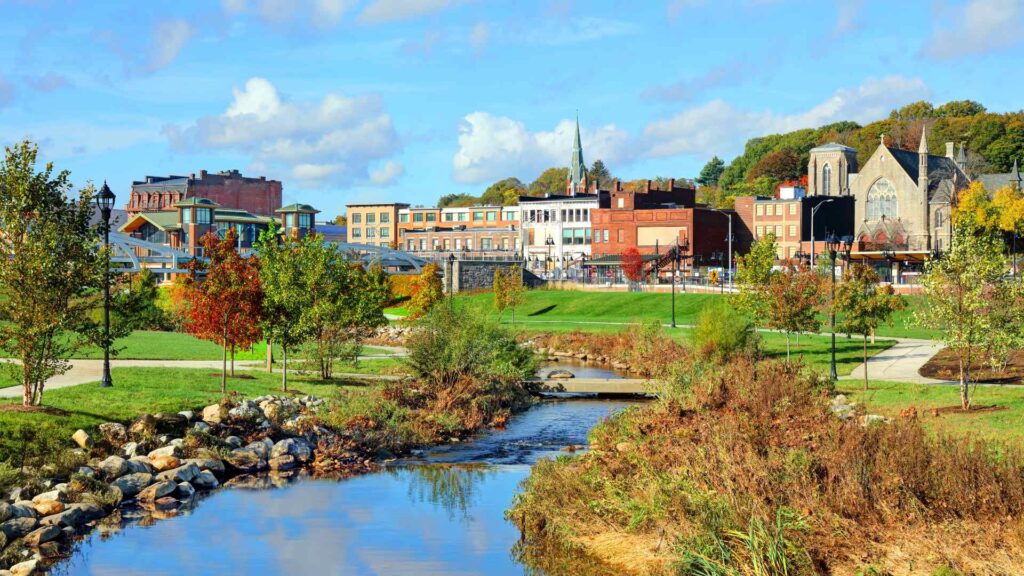Connecticut’s monikers capture the spirit of its people and the legacy of its storied past.
From “The Constitution State”to “The Land of Steady Habits,” these nicknames reveal intriguing tales, local legends, and cultural pride.
Journey through the origins, meanings, and unique traditions behind each beloved Connecticut nickname.
Why Connecticut Nicknames Matter
Connecticut nicknames offer far more than casual labels—they reflect the state’s collective identity and serve as a window into its history, culture, and regional pride.
By embracing these nicknames, residents and visitors alike can better understand the stories that shaped Connecticut’s past and continue to influence its present.
Nicknames cultivate a sense of belonging and nostalgia, linking modern generations with those that laid the foundation for the communities we see today.

Why do nicknames matter in a broader sense?
- Connection to History: Nicknames often have roots in significant events, local lore, and cultural practices, helping preserve heritage.
- Boost in Tourism: Unique monikers spark curiosity, drawing visitors eager to uncover the tales behind the names.
- State Pride: Embracing a nickname becomes a point of unity for residents, fostering a shared sense of camaraderie.
Symbolism and Identity
Connecticut’s nicknames are symbolic touchpoints that tell us how people once saw the region and how the state wants to be remembered.
Whether you’re a visitor curious about local culture or a life-long resident, these nicknames serve as threads weaving together diverse experiences, accomplishments, and ambitions.
By understanding why nicknames matter, you gain a deeper appreciation for the traditions, values, and attitudes that define the Connecticut spirit.
Let this guide spark your enthusiasm for discovering each name’s backstory and help you see how a label can be much more than just words.

The Constitution State: Roots of the Official Nickname
Officially recognized and emblazoned on license plates and state documents, “The Constitution State” captures the heart of Connecticut’s political legacy.
This moniker traces its origins to Connecticut’s significant contributions to the U.S. Constitution, as well as its own pioneering colonial charter and early governance models.
How did it all begin?
In 1639, Connecticut’s Fundamental Orders—often deemed one of the first written constitutions—laid the groundwork for a democratic government, influencing America’s broader political tapestry.
These documents outlined a system that hinged on the consent of the governed, an idea that later crystallized in the U.S. Constitution.
Key Historical Moments
- Fundamental Orders (1639): Enforced collective governance.
- The Great Compromise (1787): Proposed by Connecticut’s Roger Sherman, this crucial agreement shaped the U.S. bicameral legislature.
- Recognition as The Constitution State: Connecticut’s pivotal role secured its legacy and official state nickname.
When you see “The Constitution State” on signage or hear it in conversation, remember that it’s more than a simple phrase. It represents revolutionary ideas of democracy, equality, and civic duty.
From the storied halls of Hartford’s State Capitol to lively historical reenactments, Connecticut thrives as a testament to the frameworks that underpin American governance today. Its official nickname is a daily reminder of the enduring influence of these foundational ideals.
The Nutmeg State: A Spicy Slice of History
“The Nutmeg State,” Connecticut’s most whimsical nickname, sparks curiosity and conversation wherever it’s mentioned. But why nutmegs—an exotic spice not even grown locally?
This moniker emerged from a blend of folklore, cunning Yankee ingenuity, and historical trading practices.
Legend has it that Connecticut merchants, famed for their craftiness, traded wooden nutmegs for real spice to unsuspecting buyers.
While some historians argue this tale borders on myth, it’s widely believed that Connecticut traders were so inventive that they mastered the art of whittling wooden replicas.
This reputation for Yankee cleverness morphed into a story about fake nutmegs, cementing the state’s association with the prized spice.
Culinary Influence
- Nutmeg in Colonial America: A go-to flavoring for everything from pies to puddings.
- Trading Routes: Connecticut sea captains made the spice accessible in New England.
- Nutmeg’s Symbolic Value: Stands for wit, entrepreneurship, and adaptability.
Despite its uncertain origins, the label “Nutmeg State” has endured, painting Connecticut as a place of innovation and resourcefulness.
Even if the wooden nutmeg story is apocryphal, it remains a charming anecdote that speaks to the state’s enterprising spirit.
Next time you sprinkle nutmeg into a recipe, remember the legends of sharp-witted merchants who helped shape Connecticut’s identity.

The Provisions State: Savoring Culinary Tales
“The Provisions State” is a less commonly cited but equally compelling nickname for Connecticut.
Rooted in the American Revolution, this title hails from the essential food supplies the state provided to Continental troops.
At a time when sustenance was critical for morale and survival, Connecticut’s farmers, merchants, and resourceful citizens stepped up to feed the rebellion.
A Revolutionary Role
- Abundant Agriculture: The state’s fertile land allowed for successful farming of grains, livestock, and produce.
- Transport and Distribution: With its strategic ports and roads, Connecticut easily funneled provisions to the front lines.
- Economic Growth: Supplying the Continental Army stimulated local economies, establishing an early manufacturing base.
This nickname underscores the broader tradition of culinary excellence that still thrives in modern Connecticut.
Today, you’ll find an array of farm-to-table restaurants, lively farmer’s markets, and local producers who celebrate agricultural heritage. Chefs across the state draw inspiration from early colonial recipes, preserving a link to the past through the flavors of the land.
While “The Provisions State” might not be as well-known as other monikers, it reminds us that Connecticut’s resilience and ability to nourish those in need stem from centuries of experience.
The next time you enjoy a hearty New England clam chowder or a slice of homemade pie, consider the state’s proud legacy of providing for others.
The Land of Steady Habits: A Testament to Character
“The Land of Steady Habits” paints a picture of Connecticut as a place where tradition, reliability, and moral fortitude thrive.
This nickname emerged in the early 19th century, referencing the steadfast social and political norms that shaped life in the state.
It speaks to a culture that has consistently valued order, conscientiousness, and a measured approach to change.
Cultural Roots
- Religious Foundations: Many early settlers were devout Puritans, setting high moral standards.
- Political Conservatism: Connecticut historically upheld stable leadership and governance.
- Social Traditions: Local communities prized family values and community engagement.
While modern Connecticut has evolved, the essence of steady habits remains.
From its well-maintained town greens to a strong commitment to education, the state continues to rely on dependable systems and consistent values.
Many of Connecticut’s older institutions—libraries, universities, and historical societies—reflect this passion for preserving what works.
Still, “The Land of Steady Habits” doesn’t imply resistance to progress. Instead, it suggests a thoughtful transition toward new ideas without discarding traditions that have proven beneficial.
To this day, you’ll see examples of these steady habits in small-town festivals celebrating centuries-old crafts, or in local governance that aims for balanced innovation. This nickname is a reminder that, sometimes, being steady can be the most powerful path to lasting prosperity.
Other Popular Nicknames and Local Favorites
Beyond “The Constitution State,” “The Nutmeg State,” and others, Connecticut boasts a slew of lesser-known but equally descriptive nicknames.
These monikers offer fresh perspectives, focusing on local peculiarities, historical events, and cultural quirks. Here are some beloved alternatives you might encounter:
- “The Arsenal of the Nation”: Reflects Connecticut’s robust arms manufacturing history, particularly during the Civil War and World Wars, when the state’s factories supplied vital weaponry.
- “Blue Law State”: Stems from strict Puritanical regulations on Sunday activities, such as prohibiting certain transactions and amusements.
- “Yankee Land”: Emphasizes the strong Yankee identity in Connecticut, highlighting resourcefulness and a can-do spirit.
Regional Variations
- Southern Connecticut: Sometimes referred to as the “Gold Coast” due to wealth and proximity to New York City.
- Northern & Eastern Connecticut: Dubbed “Quiet Corner” or “Last Green Valley” for its pastoral landscapes.
While some of these names are less official, they continue to resonate with locals proud of their heritage.
They also remind visitors that Connecticut’s identity isn’t static—different parts of the state boast unique stories, industries, and traditions.
As you travel from the bustling suburbs of Fairfield County to the rural serenity of the Northeast, you’ll discover each area’s subtle claim to fame. Embrace these nicknames as windows into the many facets of Connecticut’s ever-evolving story.
Nicknames in Pop Culture and Media
Connecticut’s many nicknames have found their way into films, television shows, music, and even advertising campaigns.
Whether it’s a fictional character referencing “The Constitution State” in a political drama, or comedic jabs about being from “The Nutmeg State,” pop culture outlets have long recognized Connecticut’s unique identity.
Memorable Mentions
- TV series and sitcoms: Characters from Connecticut often mention the state’s refined, steady habits or deep historical roots.
- Sports broadcasting: Commentators sometimes highlight the state’s proud monikers during games featuring teams like the UConn Huskies.
- Music: Local artists weave references to the Quiet Corner, Nutmeg, or Blue Laws into their lyrics, celebrating home.
These cultural nods serve not only as entertaining Easter eggs but as reminders of Connecticut’s enduring presence in the American consciousness.
They also foster a sense of community pride among residents who take delight in spotting inside references.
By inserting these nicknames into storylines, showrunners and content creators help keep local traditions alive, introducing them to broader audiences.
While some references might verge on stereotype—like emphasizing a stoic Yankee demeanor—they still tie back to real historical or cultural roots.
In many ways, the mainstream media helps preserve these monikers and ensures they remain a living part of Connecticut’s identity for generations to come.
Embracing the Diversity of Connecticut Communities
A single nickname rarely captures the full spectrum of a state’s identity. For Connecticut, its rich tapestry of cultures and communities adds layers of meaning to every moniker.
Home to bustling urban centers like Bridgeport, Hartford, and New Haven, as well as sleepy villages tucked away in lush farmland, Connecticut showcases a remarkable diversity that resonates through its nicknames.
Cultural Mosaic
- Ethnic Enclaves: From vibrant Italian neighborhoods in New Haven to Polish communities in New Britain, each city bears its unique heritage.
- Academic Influence: Renowned institutions like Yale University and the University of Connecticut draw scholars from around the world, shaping local culture.
- Industrial Roots: Former manufacturing hubs, such as Waterbury and Windsor Locks, still celebrate their mill-town past.
When you explore Connecticut’s local festivals—like the Saint Patrick’s Day Parade in Hartford or the Puerto Rican Day Parade in Bridgeport—you experience the state’s multiplicity of traditions firsthand.
Despite these differences, the nicknames unite residents under a common banner, reflecting shared values of stability, enterprise, and community spirit.
This spirit of inclusivity means that, whether you identify most with “The Nutmeg State” or “The Constitution State,”you’re part of Connecticut’s story. Each community weaves its own thread into the broader state narrative, ensuring that Connecticut’s nicknames remain living symbols of unity, tradition, and growth.
Connecting Through Connecticut Nicknames: A Symbol of Pride
When you hear someone say “I’m from The Constitution State,” they’re tapping into a legacy of civic engagement.
When another exclaims “All hail The Nutmeg State!” they’re recalling tales of merchant ingenuity and a warm sense of local humor.
These nicknames serve as symbols of pride, bridging generational divides and offering a point of connection for anyone who calls Connecticut home—or simply appreciates its history.
Ways to Participate
- Collect Memorabilia: From t-shirts emblazoned with “The Nutmeg State” to commemorative coins recognizing the Fundamental Orders, show your pride.
- Attend Local Events: Many fairs, parades, and festivals incorporate the state’s nicknames, celebrating the values and traditions they represent.
- Social Media Sharing: Use hashtags or location filters referencing Connecticut nicknames to spark conversation and share experiences.
Nicknames can also inspire friendly rivalries among New England neighbors.
A Bostonian might tease a friend from “The Land of Steady Habits” for being too traditional, while a Connectican can retort with a friendly jab.
All in good fun, these interactions highlight how nicknames bring people together under the umbrella of shared identity.
In the end, “Connecticut nicknames” are more than historical footnotes. They offer insight into what has shaped the state, how communities persevere, and why many residents remain fiercely loyal to the place they call home.
